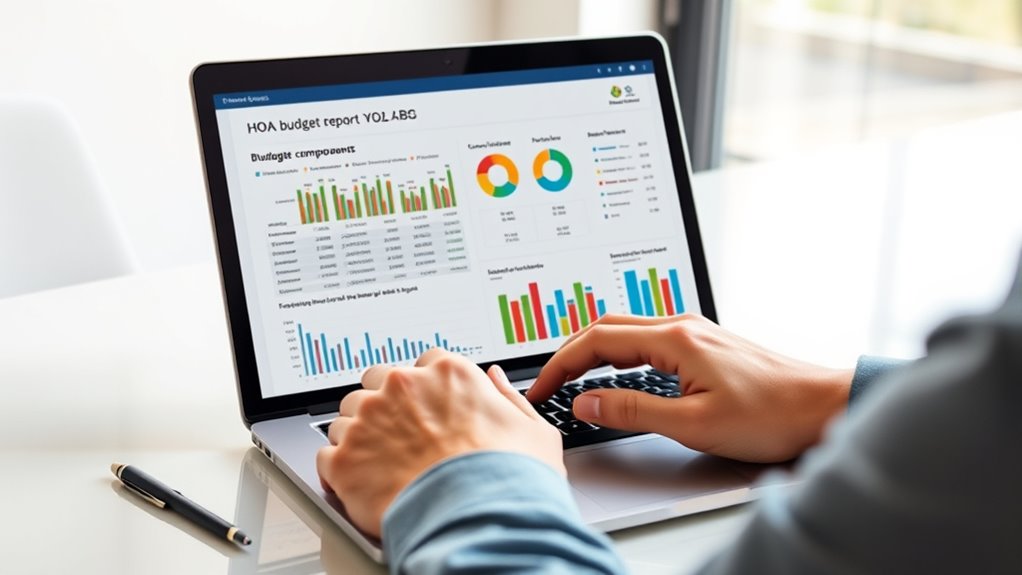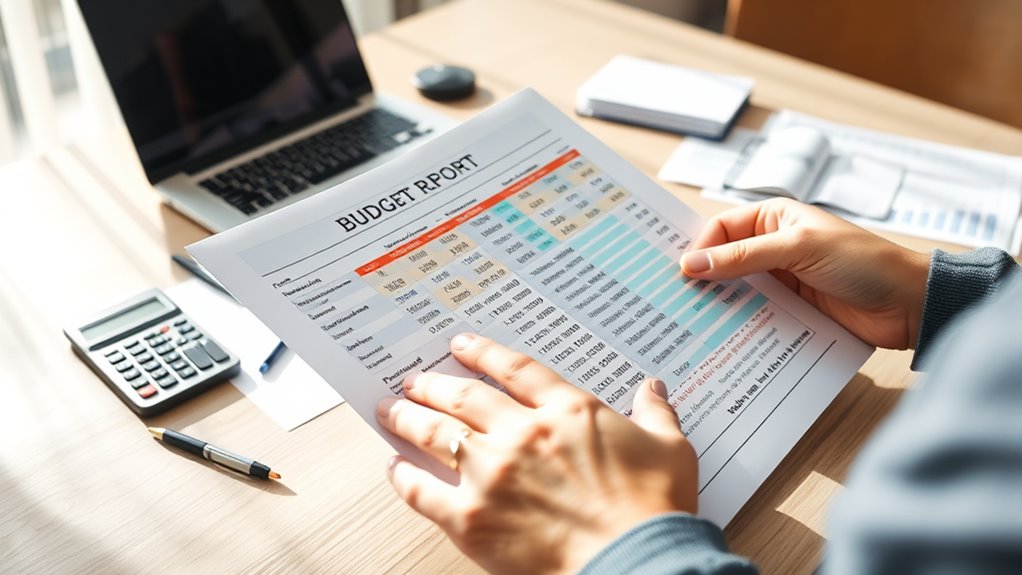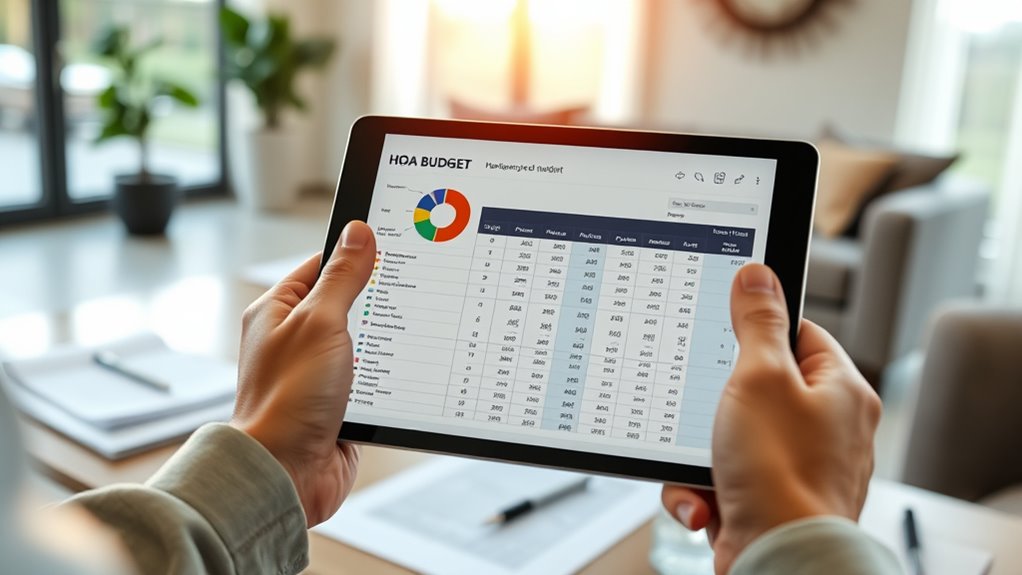When you look at an HOA budget and fees, start by understanding the income sources like assessments and additional charges. Review how the funds are allocated across maintenance, repairs, and reserves. Compare the budgeted figures to actual expenses to see if costs are rising. By recognizing trends and special assessments, you can better grasp your community’s financial health. Keep exploring the details, and you’ll gain clearer insight into how your fees support community upkeep and improvements.
Key Takeaways
- Understand the revenue sources like assessments, amenities, and special fees to grasp how funds are generated.
- Review expense categories such as maintenance, administration, and reserves to see how funds are allocated.
- Analyze budget vs. actual expenses to identify overspending or savings and ensure financial health.
- Check reserve fund status and planned contributions to assess future funding for major repairs.
- Recognize any special assessments or one-time charges that may impact overall fees and budgeting.
Understanding the Purpose of an HOA Budget

Understanding the purpose of an HOA budget is essential because it guides how your community’s funds are managed and spent. It acts as a financial plan that ensures there’s enough money to cover maintenance, repairs, and community projects. When you review the budget, you’ll see how your fees contribute to the overall financial health of the neighborhood. It also helps prevent unexpected expenses by planning for future costs. Knowing this purpose allows you to comprehend why certain fees are necessary and how they support community amenities and services. Additionally, a well-structured budget reflects financial planning strategies that promote long-term stability. By grasping the budget’s role, you can feel confident that your community’s finances are transparent and well-organized, promoting trust and accountability among residents. Understanding the allocation of funds within the budget can further clarify how resources are prioritized for community needs. Recognizing how these allocations are determined can also shed light on the community’s fund management practices, ensuring responsible stewardship of residents’ contributions. Being aware of reserve funds and their purpose can also help residents understand how future large projects are financed without sudden fee increases. Moreover, understanding the financial health of the HOA can help residents identify potential financial risks and areas for improvement.
Key Components of an HOA Budget Report

When reviewing an HOA budget report, you’ll want to understand the revenue sources and how they contribute to your community’s finances. It’s also important to look closely at the expense allocation details to see where funds are being spent. These components help you get a clear picture of the financial health of your HOA. Additionally, understanding the best anime movies can provide cultural insights into storytelling, which can be useful when engaging with community events or discussions. Recognizing the importance of financial transparency can foster trust and ensure the community remains well-informed about their collective expenditures.
Revenue Sources Breakdown
A typical HOA budget relies on several key revenue sources that keep the community running smoothly. The main income usually comes from regular assessments paid by homeowners. These fees fund ongoing maintenance, security, and administrative costs. Other sources include special assessments for unexpected expenses or major projects, and income from amenities like rental facilities or leasing community spaces. Some HOAs also generate revenue through advertising or partnership programs. Here’s a quick overview:
| Revenue Source | Description | Frequency |
|---|---|---|
| Regular assessments | Monthly or quarterly homeowner fees | Ongoing |
| Special assessments | One-time fees for large projects | As needed |
| Amenity fees | Rental income from amenities | Variable |
Understanding these sources helps you grasp how your fees support community needs and ensures the financial sustainability of the HOA. Additionally, effective management of these revenue streams contributes to long-term community stability and supports future improvements. Proper oversight of revenue collections can also help prevent financial discrepancies and promote transparency in community finances. Moreover, clear understanding of the revenue sources can assist homeowners in making informed decisions regarding community investments. Effective revenue management also plays a crucial role in benefiting homeowners by maintaining property values and community quality.
Expense Allocation Details
Expense allocation is the core component of an HOA budget report, detailing how funds are distributed across various community needs. It shows you where your money goes each year. Imagine, you’re looking at a pie chart divided into sections:
- Maintenance and Repairs – the slice for fixing landscaping, roads, or buildings.
- Administrative Costs – covering management, insurance, and office expenses.
- Reserve Funds – saving for future big-ticket projects or emergencies. This breakdown helps you understand priorities and whether funds are allocated prudently. You can see if essential services are adequately funded or if some areas may need more attention. Clear expense allocation ensures transparency and accountability, giving you confidence in how your fees support the community’s well-being. Understanding community financial management can also promote community wellness initiatives within your HOA. Additionally, reviewing the financial transparency of these allocations can help build trust among residents and encourage active participation in community decision-making. Being aware of the funding allocation process can further enhance your understanding of how resources are prioritized to maintain the community’s quality and safety. Regularly reviewing budget reports can also reveal potential cost savings that benefit the community overall.
Analyzing Income Sources and Revenue

Have you ever wondered where HOA funds come from? Most of the revenue derives from homeowner assessments, which are the regular fees residents pay monthly or annually. These assessments cover common area maintenance, amenities, and administrative costs. Some HOAs also generate income through fees for specific services, like parking or clubhouse rentals. Additionally, they might earn interest from reserve accounts or investments. It’s important to review the budget to see how much money each source contributes and whether the revenue is sufficient to cover upcoming expenses. Keep an eye on any special assessments or one-time charges that could impact your costs. Understanding where the money comes from helps you grasp the HOA’s financial health and ensures transparency in how funds are allocated. Monitoring cookie analytics can provide insights into the overall financial performance and operational efficiency of the HOA, including electric power generation and other sustainable funding methods. Recognizing the importance of revenue streams can help residents better understand the sustainability of HOA finances over time.
Examining Operating Expenses and Maintenance Costs

Understanding your HOA’s operating expenses and maintenance costs helps you see where your fees go. Breaking down routine maintenance reveals which tasks are ongoing and essential. Tracking expense trends can also highlight areas where costs are rising or staying steady over time.
Routine Maintenance Breakdown
Routine maintenance is an essential part of managing your HOA’s budget, ensuring that common areas and shared facilities stay in good condition without unexpected costs. Regular upkeep prevents small issues from becoming major expenses. When reviewing your budget, focus on these key areas:
- Landscaping and lawn care, keeping grounds lush and free of weeds.
- Pool and playground maintenance, ensuring safety and cleanliness.
- Building exterior repairs, like painting, roofing, and siding upkeep.
Operating Expense Trends
Tracking how operating expenses and maintenance costs change over time helps you identify patterns and make informed budget decisions. Reviewing these trends reveals whether costs are rising steadily or spiking unexpectedly, so you can anticipate future financial needs. For example, if maintenance costs increase annually, it may indicate aging infrastructure requiring more repairs. Conversely, stable expenses suggest effective management. Identifying specific expense categories that grow faster than others helps you prioritize cost control measures. Monitoring these patterns also guides your HOA in setting realistic fees and allocating reserves appropriately. By understanding expense trends, you can spot inefficiencies early and advocate for preventive measures. Ultimately, keeping a close eye on operating costs ensures the HOA remains financially healthy and can sustain quality maintenance and services.
Reviewing Reserve Funds and Capital Reserves

Reviewing reserve funds and capital reserves is essential to verify your HOA can cover future repairs and upgrades without unexpected assessments. These funds are set aside for major projects like roof replacements, elevator upgrades, or landscaping overhauls. To assess their adequacy, consider:
- The balance of reserve funds compared to projected costs for upcoming repairs.
- The frequency and size of past contributions to ensure steady growth.
- The plan for future funding, including planned increases or special assessments if needed.
A healthy reserve indicates your community is prepared for major expenses, reducing financial surprises. If reserves are underfunded or not aligned with projected needs, you might face special assessments or delays in necessary repairs. Regularly reviewing these reserves safeguards your investment.
Identifying Special Assessments and Additional Fees

Understanding when your HOA might impose special assessments or additional fees is crucial for managing your finances. These charges aren’t part of your regular dues and are usually unexpected, often linked to major repairs or unexpected expenses. To identify them, review the HOA’s budget and meeting minutes, where special assessments are typically discussed. Look for sections labeled “Special Assessments” or “Additional Fees,” which specify upcoming or potential charges. Keep an eye on notices from your HOA, as they’ll inform residents about planned assessments or special charges. Recognizing these fees early helps you plan your budget accordingly, avoiding surprises that could strain your finances. Staying informed ensures you’re prepared for any extra costs that may arise beyond your regular fees.
Comparing Budgeted vs. Actual Expenses

Comparing your HOA’s budgeted expenses to the actual costs incurred is essential for maintaining financial transparency and planning ahead. It helps you spot variances early and understand where money is going. To do this effectively, imagine these steps:
- Visualize a side-by-side chart showing the budgeted amount versus actual expenses for each category, like landscaping or repairs.
- Picture highlighting areas where actual costs are higher than budgeted, signaling potential overspending.
- Envision reviewing these differences regularly, like monthly, to identify patterns and adjust future budgets accordingly.
Recognizing Trends and Predicting Future Costs

By analyzing your HOA’s expense data over time, you can identify patterns that reveal how costs fluctuate seasonally or due to ongoing issues. Look for recurring spikes in maintenance, landscaping, or utilities, which often align with specific times of the year. Tracking these trends helps you anticipate upcoming expenses and adjust your expectations accordingly. For example, if you notice higher snow removal costs every winter, you can plan for those increases in your budget. Additionally, identifying rising costs over multiple years can signal underlying issues that might require attention or renegotiation with vendors. Recognizing these patterns allows you to predict future costs more accurately, ensuring your HOA remains financially healthy and prepared for upcoming needs.
Questions to Ask Your HOA Board or Management

What questions should you ask your HOA board or management to guarantee you’re fully informed about the community’s financial health? Start by asking how much reserve fund balance the community currently has and if it’s sufficient for emergencies. Next, inquire about upcoming projects or special assessments that could impact fees. Finally, ask for details on the HOA’s recent financial audits or reviews to ensure transparency. Visualize the community’s financial stability like a sturdy foundation, a clear blueprint for future upgrades, and transparent financial reports. These questions help you gauge whether the HOA is financially prepared for both expected expenses and unexpected costs, giving you confidence in your investment and peace of mind.
Frequently Asked Questions
How Often Is the HOA Budget Reviewed and Updated?
You might wonder how often the HOA budget gets reviewed and updated. Typically, your HOA board reviews the budget annually to guarantee it reflects current expenses and financial goals. Some HOAs may conduct semi-annual or quarterly reviews, especially if there are significant changes in costs or special projects. Staying informed about these updates helps you understand how your fees are allocated and ensures the community’s financial health.
Can I Access the Detailed Financial Statements Behind the Budget?
Imagine opening a treasure chest and finding its secrets inside—that’s what accessing detailed financial statements feels like. Yes, you can usually request these documents from your HOA’s management or board. They’re meant to be transparent, so don’t hesitate to ask for copies. Review these statements carefully to understand where your fees go and ensure everything aligns with the budget. Your HOA’s financial health is your right to be informed about.
What Happens if the HOA Exceeds Its Budgeted Expenses?
If the HOA exceeds its budgeted expenses, it typically means the community may need to cover the shortfall through increased fees or special assessments. You might see higher monthly dues or occasional charges for unexpected costs. The HOA board is responsible for managing these overspending situations, and they usually communicate openly with residents about the reasons and plans to address the financial gap. Staying informed helps you understand how it impacts your finances.
Are There Any Penalties for Late or Unpaid Fees?
If you don’t pay your HOA fees on time, you could face penalties like late fees or interest charges. Consistently late payments might lead to more serious consequences, such as fines or even legal action. To avoid these issues, it’s best to pay your fees promptly. If you’re having trouble, contact your HOA to discuss payment plans or assistance options before penalties accumulate.
How Are Reserve Fund Contributions Determined and Adjusted?
You might wonder how reserve fund contributions are set and changed. Typically, the HOA board reviews the reserve study, which estimates future repair costs and replacement needs. They then determine a contribution amount based on this study, often factoring in inflation and project timelines. If costs or priorities shift, the board can adjust contributions accordingly, ensuring there’s enough money for major repairs without burdening owners excessively.
Conclusion
So, next time you review your HOA budget, remember it’s more than just numbers—it’s your community’s future. Ironically, what seems like dry figures can reveal surprises lurking beneath. By understanding these details, you gain power, not just to pay fees but to shape your neighborhood’s fate. Don’t let the fine print trick you—because ignoring it could mean paying more than you bargained for, all while pretending everything’s under control.









